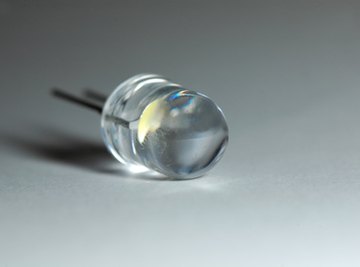
Light-emitting diodes have graduated well beyond their initial roles as panel indicator lights. Now LEDs are used for applications such as flashlights, automobile headlights and architectural lighting. Although LEDs are readily available, they're not very useful unless the light they generate can be routed from where it is to where it needs to be.
For use as laboratory sources, it's often valuable to collimate the light from an LED, to turn it into a "light beam." The calculations are more involved when using high-power LEDs for specialty or general lighting.
Using an LED as a Collimated Source
Identify the illumination pattern for the LED. Usually the manufacturer will, at a minimum, provide the divergence angles in the x and y directions.
As an example, assume the LED has a divergence of 38 degrees in x and 47 degrees in y.
Determine the appropriate focal lengths to get the desired beam size.
The focal length is given by the formula f = D/(2*tan(alpha/2)), where D is the desired beam diameter and alpha is the full beam divergence in the direction in question.
For this example, take a desired beam diameter of 25 mm. Then,
fx = 25/(2_tan(38/2) = 36 mm fy = 25/(2_tan(47/2) = 29 mm
Place the shorter focal length cylindrical lens at its own focal length away from the LED.
In the example, a cylindrical lens with a focal length of 29 mm will be placed 29 mm away from the LED, oriented so that it focuses the y direction.
Mark an index card with the desired beam diameter, and check to see that the beam stays at that size over the required distance. Adjust the position of the lens to keep the beam in the desired diameter.
In the example, the index card will have a 25 mm diameter circle, and the lens is adjusted to keep the vertical dimension of the beam as nearly as possible within the circle.
Place the longer focal length lens its own focal length away from the LED.
For the example, a cylindrical lens with a focal length of 36 mm is placed 36 mm away from the LED, oriented so that it focuses the x direction.
Adjust the second lens position to optimize the collimation. Use the index card as a guide.
To complete the example, adjust the 36 mm focal length lens to keep the width of the beam as nearly as possible within the circle.
Select an appropriate anamorphic prism pair. An alternative to two cylindrical lenses is to place an anamorphic prism pair close to the LED, which circularizes the beam, equalizing the divergence in the x and y directions. A single lens with the focal length collimates the beam.
Using LEDs for Illumination
- LED datasheets
- Cylindrical lenses or an anamorphic prism pair
- Index card
- Optical design program
Collimation is never perfect, especially with LED sources, because they are not point sources. Accept some divergence in the collimated beam.
High-power LEDs suitable for illumination are significantly different from small-indicator LEDs. The high-power devices aren't just brighter; they are also physically larger and have a more uniform illumination pattern.
Find the output pattern for the LED. Whether the white color is created by superimposing light from LED chips of different colors, or by emission from a phosphor-coated ultraviolet LED, the emission pattern is the starting point. Manufacturer’s data sheets provide this information.
Define the desired illumination pattern. A desktop task light and a streetlight have quite different target illumination patterns.
Model the system in an optical design program. These programs accept manufacturer’s data files as input, then propagate the light through a user-defined optical system, and calculate the final illumination pattern.
Use the internal optimization routine of the optical design program to tweak the optical surfaces and adjust the output illumination pattern.
Things You'll Need
Tips
References
Tips
- Collimation is never perfect, especially with LED sources, because they are not point sources. Accept some divergence in the collimated beam.
- High-power LEDs suitable for illumination are significantly different from small-indicator LEDs. The high-power devices aren't just brighter; they are also physically larger and have a more uniform illumination pattern.
About the Author
First published in 1998, Richard Gaughan has contributed to publications such as "Photonics Spectra," "The Scientist" and other magazines. He is the author of "Accidental Genius: The World's Greatest By-Chance Discoveries." Gaughan holds a Bachelor of Science in physics from the University of Chicago.
Photo Credits
led image by sasha from Fotolia.com
